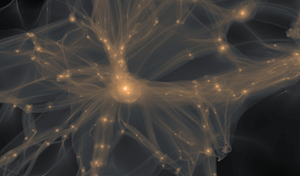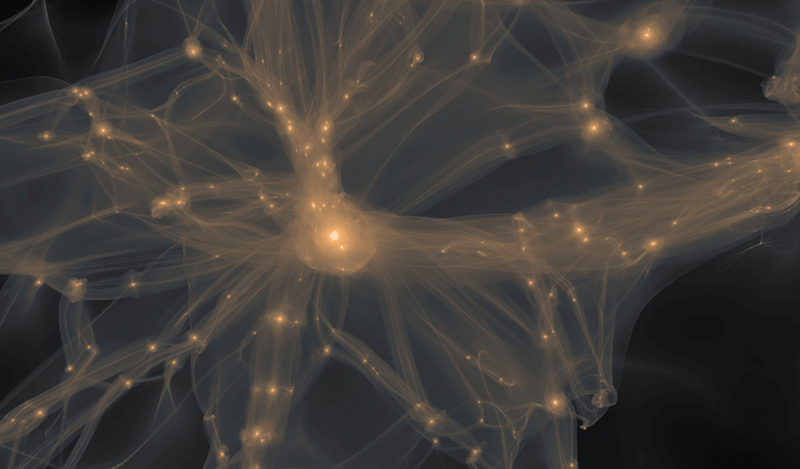2015 AAAS Meeting—Seeing is Believing
At this year’s annual meeting of the American Association for the Advancement of Science, physicists spoke about getting images of phenomena both vast (the cosmos) and minute (electron motion). Here are some highlights.
–Jessica Thomas
Dark Matter Simulations Come into Clearer Focus
Images of the Universe’s weblike structure aren’t just eye-candy; they help scientists visualize and interpret data. In a session on the art of making data beautiful, Ralf Kähler, of the Kavli Institute for Particle Physics and Astrophysics at SLAC, described new ways to convert data from cosmological simulations into images that are both magazine-cover worthy and scientifically meaningful. For example, cosmologists can simulate the evolution of dark matter after the big bang by placing up to a trillion “tracer particles” on a grid and letting them move in response to the clumping of ordinary matter. These simulations help researchers understand how, over billions of years, dark matter clumped into “halos,” the seeds of galaxy clusters. To make a continuous image from a set of points usually requires interpolation, which can create fake structures—like voids when matter is actually present—and these artifacts can mislead researchers. Kähler and his colleagues developed algorithms where space is divided up into blocks, with one tracer particle each, and the blocks move, distort, and overlap as the particles redistribute, in such a way that there is always one particle per block. Keeping track of the particle positions and the volumes of the blocks gives the mass density, and this approach turns out to prevent false structures from appearing and produces crisper, more accurate images.
Superconductors See Inside Materials
Imagine you had to guess the score of a soccer game just by listening to the cheers of the crowd. That’s the analogy Princeton physicist Ali Yazdani used to explain why electron behavior in a solid is so difficult to determine with macroscopic probes. In a session on new approaches to imaging in physics, Yazdani and Kathryn Moler of Stanford each presented a technique that relies on superconductors. Yazdani described a souped-up version of a scanning tunneling microscope (STM) with a probe tip made of a superconducting material, like lead. If this tip gets close enough to a superconducting surface, then the electrons carrying the supercurrent can tunnel from the surface into the probe. Yazdani hopes to use the technique to look for atomic-scale variations in the superconducting state that have so far been difficult to detect. Moler discussed using a SQUID (superconducting quantum interference device) to detect magnetic fields and thus image the tiny rivulets of current that form around micron-scale crystals, or “grains,” within a material. The probe could help researchers understand how grain boundaries and other defects affect a material’s performance.
Neutrinos Could Catch Black Holes in the Act
Astronomers expect to see exploding stars in our galaxy only rarely—just one core-collapse supernova every 30 years. But Kate Scholberg, a particle physicist at Duke University, says that the next time one comes around, state-of-the art neutrino detectors should be able to tell us about the remnant star’s structure and how it evolves in time. That’s because neutrinos are copiously produced in supernovae, and unlike other particles, they are weakly interacting enough to escape from deep within the star. Time-sensitive neutrino detectors could, for example, identify the formation of a post-supernova black hole, because the burst of neutrinos would end within a few seconds, when the newborn black hole begins swallowing nearby particles, Scholberg said. She warned, however, that such a clear cutoff would only be observed if a large number of neutrinos were detected. And the last supernova to produce detectable neutrinos, which appeared 28 years ago (SN1987A), only resulted in about two dozen detected neutrinos in three experiments.





